Related Research Articles
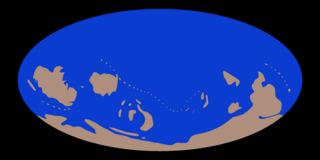
The Cambrian is the first geological period of the Paleozoic Era, and the Phanerozoic Eon. The Cambrian lasted 53.4 million years from the end of the preceding Ediacaran period 538.8 Ma to the beginning of the Ordovician Period 485.4 Ma.
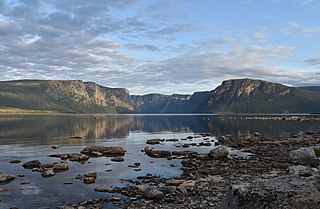
Gros Morne National Park is a Canadian national park and World Heritage Site located on the west coast of Newfoundland. At 1,805 km2 (697 sq mi), it is the second largest national park in Atlantic Canada after Torngat Mountains National Park, which has an area of 9,700 km2 (3,700 sq mi).

Avalonia was a microcontinent in the Paleozoic era. Crustal fragments of this former microcontinent underlie south-west Great Britain, southern Ireland, and the eastern coast of North America. It is the source of many of the older rocks of Western Europe, Atlantic Canada, and parts of the coastal United States. Avalonia is named for the Avalon Peninsula in Newfoundland.
Fortune Head is a headland located about 1.6 km (0.99 mi) from the town of Fortune on the Burin Peninsula, southeastern Newfoundland.

Agraulos is a genus of Solenopleuridae trilobites that lived during the Middle Cambrian in North America and Europe, particularly the Czech Republic. The genus was named by Hawle & Corda in 1847.

Newfoundland is a large island within the Canadian province of Newfoundland and Labrador. It is situated off the eastern coast of the North American mainland and the geographical region of Labrador.
Lotagnostus is a genus of very small trilobites in the order Agnostida, which lived on the outer continental shelves worldwide, during the late Upper Cambrian. It was described by Whitehouse in 1936, and the type species is Lotagnostus trisectus, which was originally described as a species of Agnostus by Salter in 1864.
Pojetaia is an extinct genus of early bivalves, one of two genera in the extinct family Fordillidae. The genus is known solely from Early to Middle Cambrian fossils found in North America, Greenland, Europe, North Africa, Asia, and Australia. The genus currently contains two accepted species, Pojetaia runnegari, the type species, and Pojetaia sarhroensis, though up to seven species have been proposed. The genera Buluniella, Jellia, and Oryzoconcha are all considered synonyms of Pojetaia.

The Terreneuvian is the lowermost and oldest series of the Cambrian geological system. Its base is defined by the first appearance datum of the trace fossil Treptichnus pedum around 538.8 million years ago. Its top is defined as the first appearance of trilobites in the stratigraphic record around 521 million years ago. This series' name was formally accepted by the International Commission on Stratigraphy in 2007.
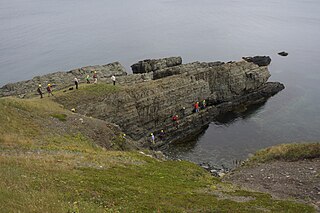
The Fortunian age marks the beginning of the Phanerozoic Eon, the Paleozoic Era, and the Cambrian Period. It is the first of the two stages of the Terreneuvian series. Its base is defined as the first appearance of the trace fossil Treptichnus pedum 538.8 million years ago. The top of the Fortunian which is the base of the Stage 2 of the Cambrian has not been formally defined yet, but will correspond to the appearance of an Archeocyatha species or "Small shelly fossils" approximately 529 million years ago.
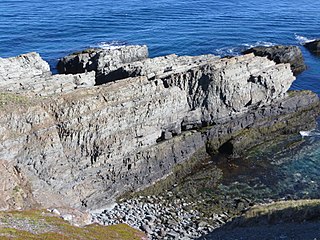
The Chapel Island Formation is a sedimentary formation from the Burin Peninsula, Newfoundland, Canada. It is a succession of siliciclastic deposits, over 1,000 metres (3,300 ft) thick, that were deposited during the latest Ediacaran and earliest Cambrian.

Pleuroctenium Hawle & Corda (1847) is an agnostid trilobite belonging to the family Condylopygidae Raymond (1913). The genus occurs in Middle Cambrian (Drumian) strata of Canada, the Czech Republic, England and Wales, France, and Sweden.
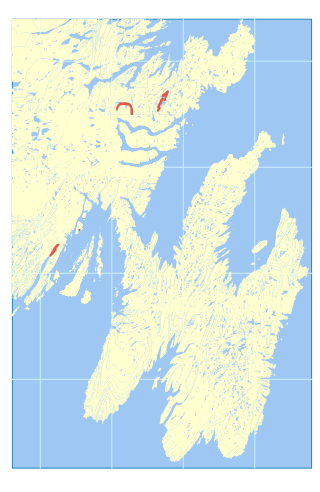
The Chamberlain's Brook Formation is a thin but distinctive geologic formation of dark red calcareous mudstones that crops out from Rhode Island to Massachusetts and, Nova Scotia, New Brunswick and Newfoundland. It preserves fossils, including trilobites, dating back to the lower mid-Cambrian period. Its lowermost member is the Braintree Member and the uppermost member is the Fossil Brook Member.
The Brigus Formation is a fossiliferous upper lower Cambrian geologic formation in Newfoundland and Labrador.

The Mistaken Point Formation is a geologic formation in Newfoundland and Labrador. It is recognized as a Lagerstätte preserving fossils dating back to the Ediacaran period. It contains a stratum dated to 565 ± 3 million years ago.

Serrodiscus Richter and Richter 1941. is a genus of Eodiscinid trilobite belonging to the family Weymouthiidae Kobayashi T. (1943), Order Agnostida. It lived during the late Lower Cambrian, with remains found in Canada, China (Gansu), The United Kingdom (England), Germany (Silesia), Poland, the Russian Federation, and the United States. It is named for the spines on the ventral side of the pygidium, which give it a serrated impression.

Bailiaspis Resser, 1936, is a Middle Cambrian (Miaolingian) trilobite genus belonging to the Family Conocoryphidae Angelin, 1854. Within the Acado-Baltic region, the genus ranges from Wuliuan into Guzhangian age strata.

The Random Formation is a rock unit in Newfoundland dating to the early Cambrian period, dominated by tidal quartz arenites deposited in a near-shore environment, but also incorporating intertidal and open-shelf deposits, including glauconitic and mud-cracked mudstones, and red channel sandstones. It was deposited quickly and is approximately 175 m (574 ft) thick. The Blue Pinion Formation was originally recognized as a separate formation, but is now interpreted as an expression of the Random Formation.
Manuels River Formation is a Middle Cambrian (Drumian) geological formation cropping out in the Random Island area of Newfoundland and elsewhere?. Its black/dark brown, finely laminated mudstones and thicker-bedded siltstones are occasionally interrupted by thin yellowish silty limestone horizons.
References
- ↑ Greene, B., and H. Williams. 1974. New fossil localities and the base of the Cambrian in southeastern Newfoundland. Canadian Journal of Earth Sciences, 11:319–323.
- ↑ https://www.researchgate.net/profile/Ed_Landing/publication/257298155_Stratigraphy_of_the_Bonavista_Group_southeastern_Newfoundland_growth_faults_and_the_distribution_of_the_sub-trilobitic_Lower_Cambrian_p_59-71_Figs_34-38_In_E_Landing_GM_Narbonne_and_P_Myrow_eds_1988_T/links/0deec524c8564b40c5000000.pdf [ bare URL PDF ]